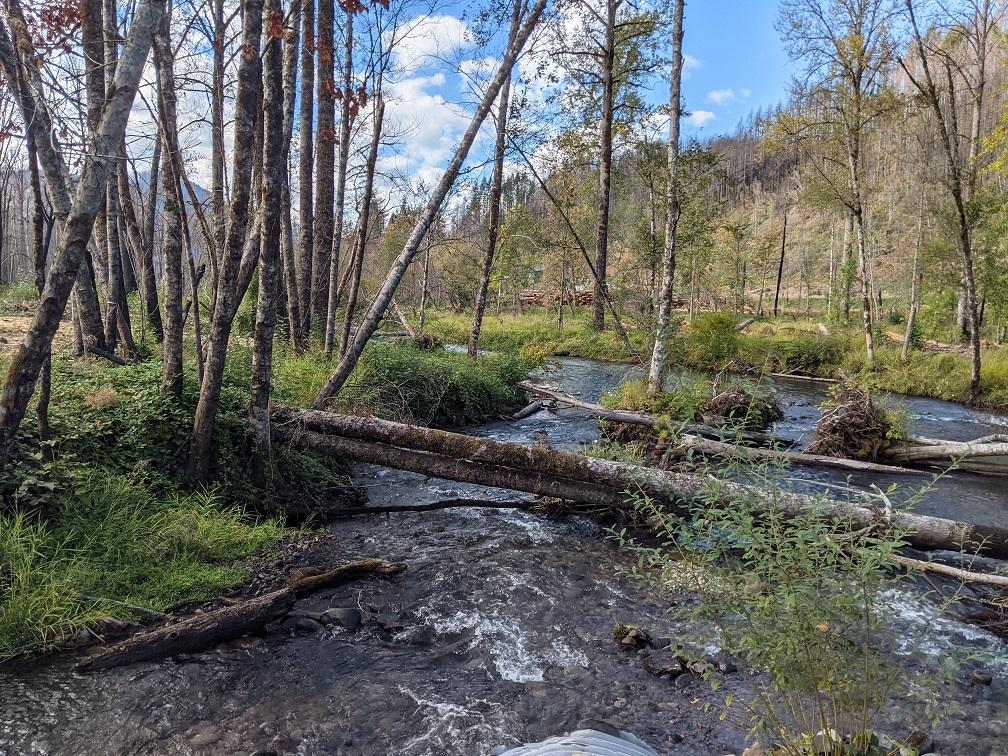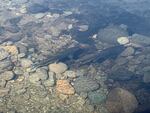
Downed trees across Elk Creek provide shady places for fish and other wildlife to shelter.
Rachael McDonald / KLCC
Salmon have returned to spawn in the waters of Finn Rock Reach in the McKenzie River. For those who worked over the summer to improve habitat there, it’s a reason to celebrate.
Just off Hwy 126 east of Eugene, Oregon, near Blue River, this 85-acre property used to be owned by a lumber company. McKenzie River Trust purchased it just over five years ago.
Joe Moll pointed to a Chinook salmon lingering in a side channel, known as Elk Creek.
“Kinda magical to think that she was born of these gravels,” Moll said. “And to think about the kind of life that she has had and the gauntlet she has had to run to become the adult that she is and come back and spawn in this same area. It’s just incredible endurance, incredible determination, and the power of life sort of stuff.”
Moll is executive director of McKenzie River Trust. In partnership with the Forest Service and other organizations, they did some work to improve spawning habitat here. That includes moving gravel and downed trees into the stream to create a more natural environment. Kate Myer is a fisheries biologist with the Willamette National Forest.
“So, they definitely key into that disturbance,” Myer said. “It’s something they’ve evolved with landslides and flooding and those kind of natural processes, kind of reset those gravels and loosen ‘em up and make them more available for spawning.”

Chinook Salmon in Elk Creek earlier in September 2021.
Joe Moll / McKenzie River Trust
Moll said much of their work is to help restore the river’s flood plain and create places for fish to shelter from the fast flowing main stem.
“It’s so important to have this range of habitats, not only for spawning but for rearing,” Moll said. “It’s like the nursery. The bigger, stronger, those young fish can be by the time they go out to the ocean, the greater the likelihood that they’ll be able to make it back.”
Here at Finn Rock, the Holiday Farm Fire, which burned through just over a year ago, is evident in the blackened trees. Moll said when they first returned to the property after the fire it was disheartening.
“In the interior forest here, there were cottonwood trees that were 20 feet around. Just big massive trees,” he said. “And old maples that had moss that was almost a foot deep. These indications of an older time, an older forest. And they were burned or toppled by the wind.”
But he said they have seen the forest come back to life. Ferns were sprouting up even as the smoke lingered last fall. And some cottonwoods survived the fire.
“And the understory is already starting to come back despite how dry a summer it’s been,” said Moll. “And so you see, it gave us a chance to recognize, okay, nature moves on its own timeline. We need to learn to work with that, and not simply try to manipulate things on our timeline.”
Kate Myer described their work as bringing back the messiness of the river’s original course.
“It’s those messy, wet conditions that our native fish and wildlife species evolved with,” Myer said. “Most river valleys don’t even resemble what they used to look like. So it’s really no wonder that our fish populations continue to decline.”
The hope is that the work here to restore the river’s natural flow and wildlife can help create a more resilient river valley. One that can withstand the challenges of a changing climate.
“How do we invest in, in this case, natural infrastructure that’s very cost-effective, so that in the next 100 years, the 300,000 people downstream relying on the McKenzie for drinking water, can enjoy what we enjoy today?” Moll said. “So, recognizing that an active flood plain keeps the water table high it retains water. That’s going to be really important as we see our rain and snow patterns shifting and our summers becoming hotter and longer and dryer.”
The project will continue over the next several years.
